When we first set out of Malia to observe birds, it was necessary to stop at a petrol station because not all of us had the same and/or sufficient amount of fuel, but here we already established the order in which we moved in the convoy. The first car was driven by Saša [Marinković], who had already visited all of these sights several times and who knew where to go to observe the griffon vultures. On this day, to start with, we went the Roza Gorge. The second car was driven by Marko and the third by me.
By the way, here is the map showing where we all went during this trip:
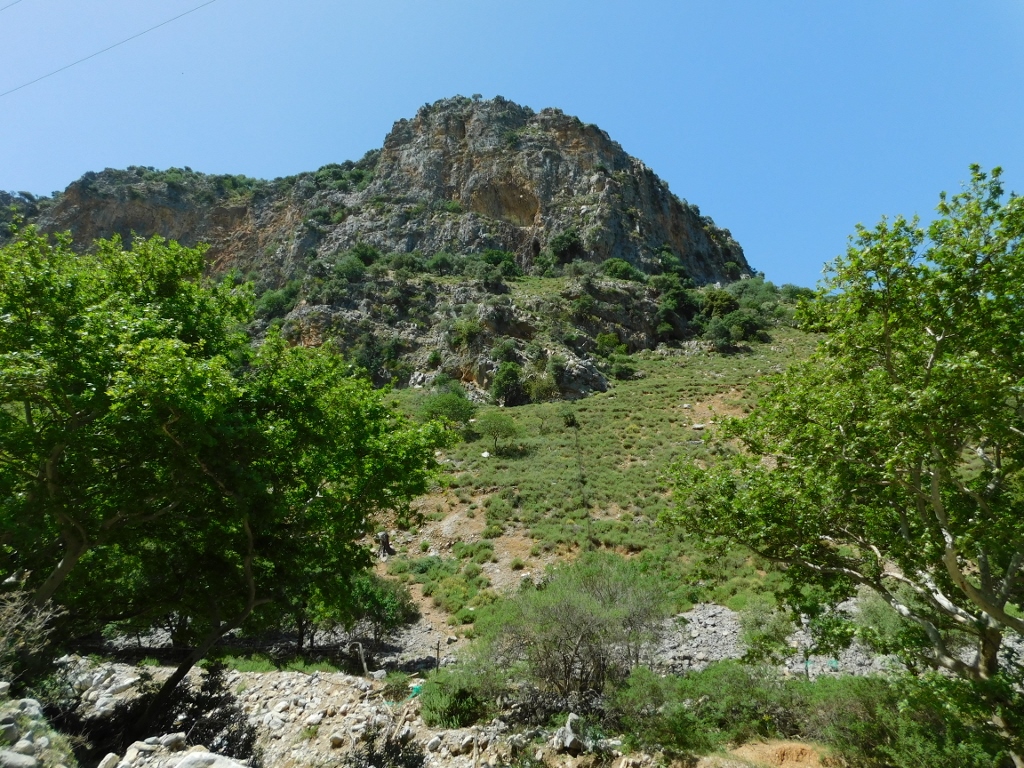 In the Roza Gorge
In the Roza Gorge
It didn’t take long before we spotted griffon vultures (Gyps fulvus).
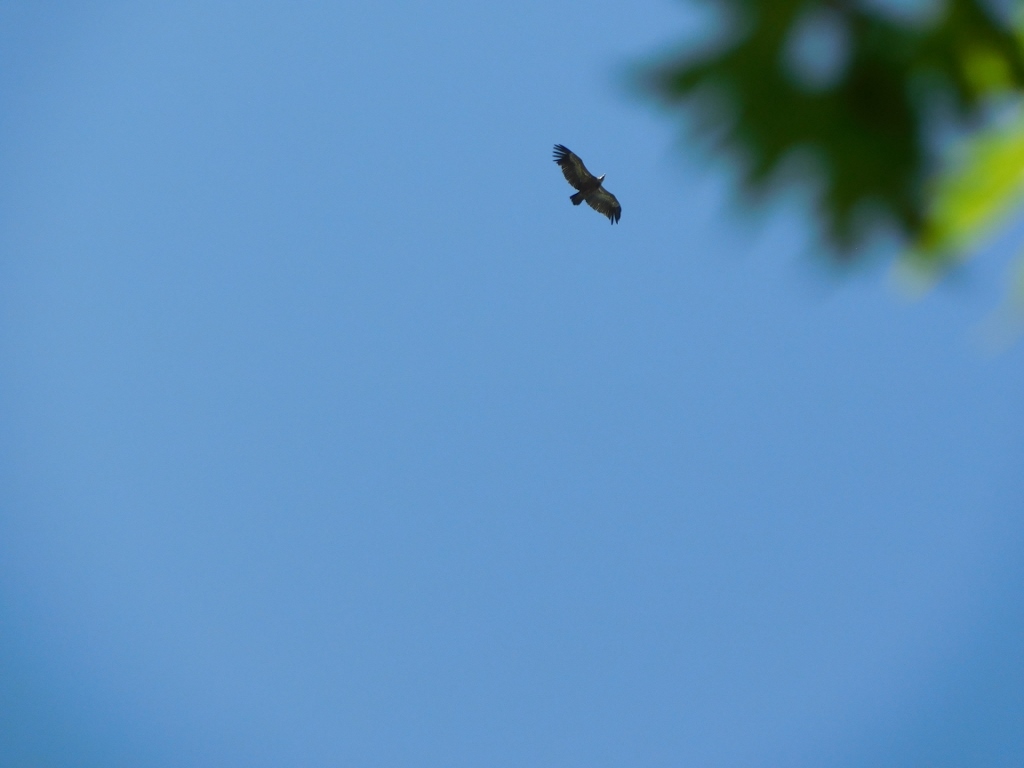 Griffon vulture
Griffon vulture
Over the past few years, I have become rather skilled at tracking vultures in the sky with my camera, which is (now) easy for me since they are large and soar gracefully, but I had significant difficulties it the beginning.
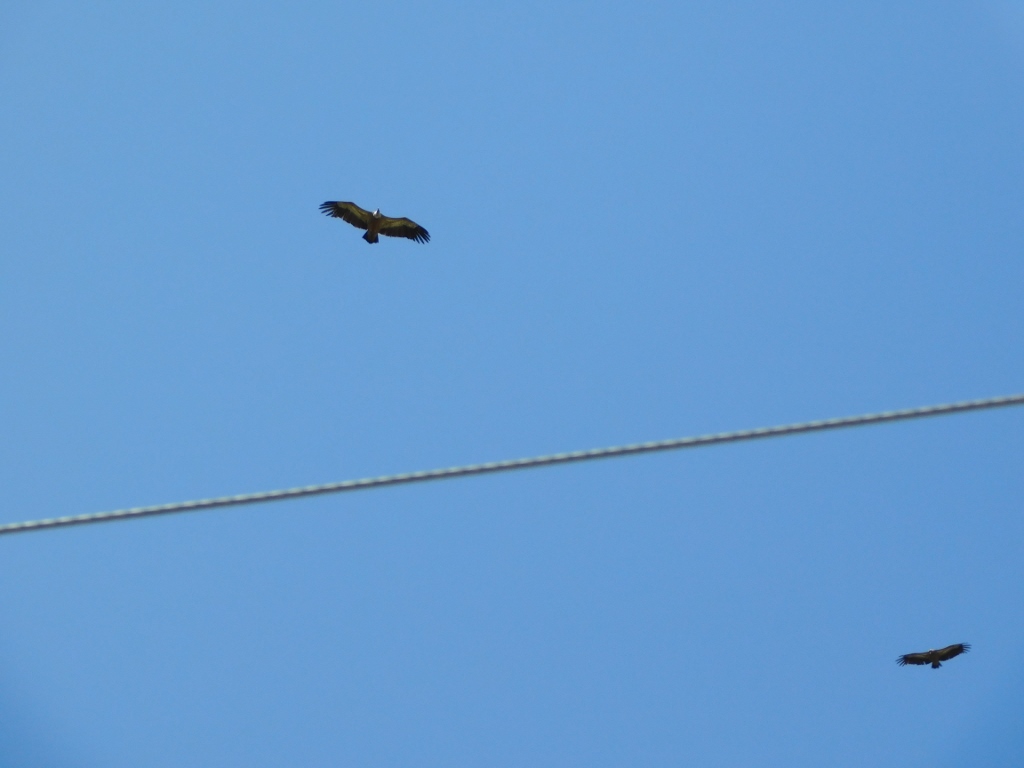 Griffon vultures
Griffon vultures
On this occasion, I even filmed them flying alongside the cliffs, as well as perching or landing on them.
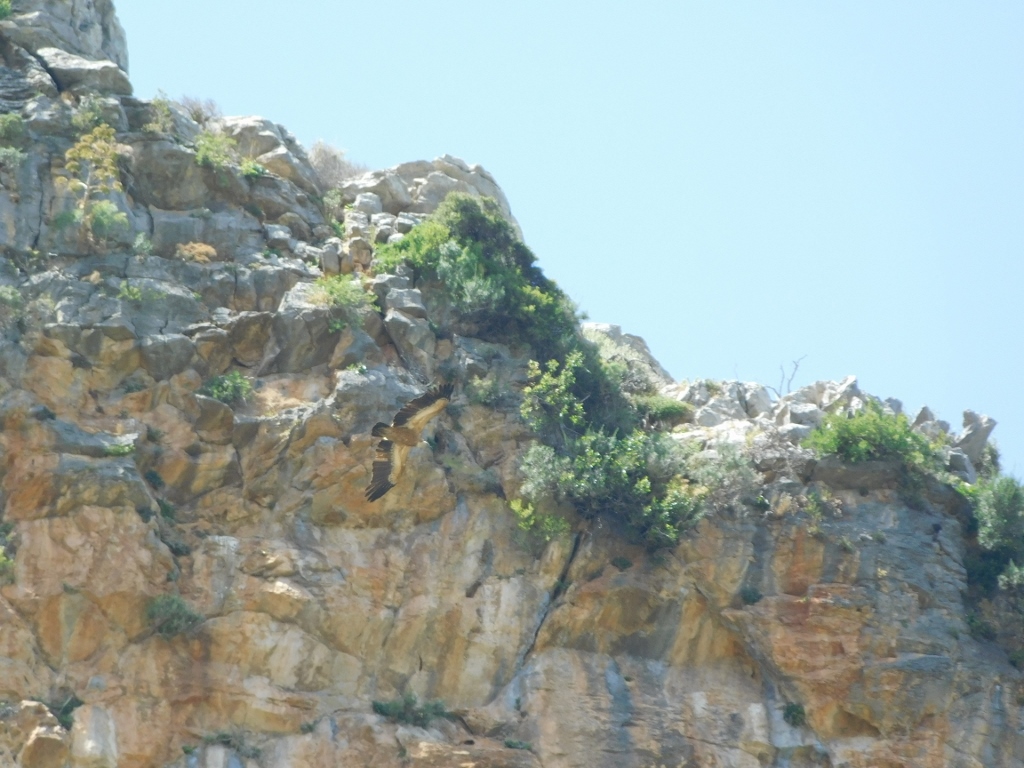 Griffon vulture
Griffon vulture
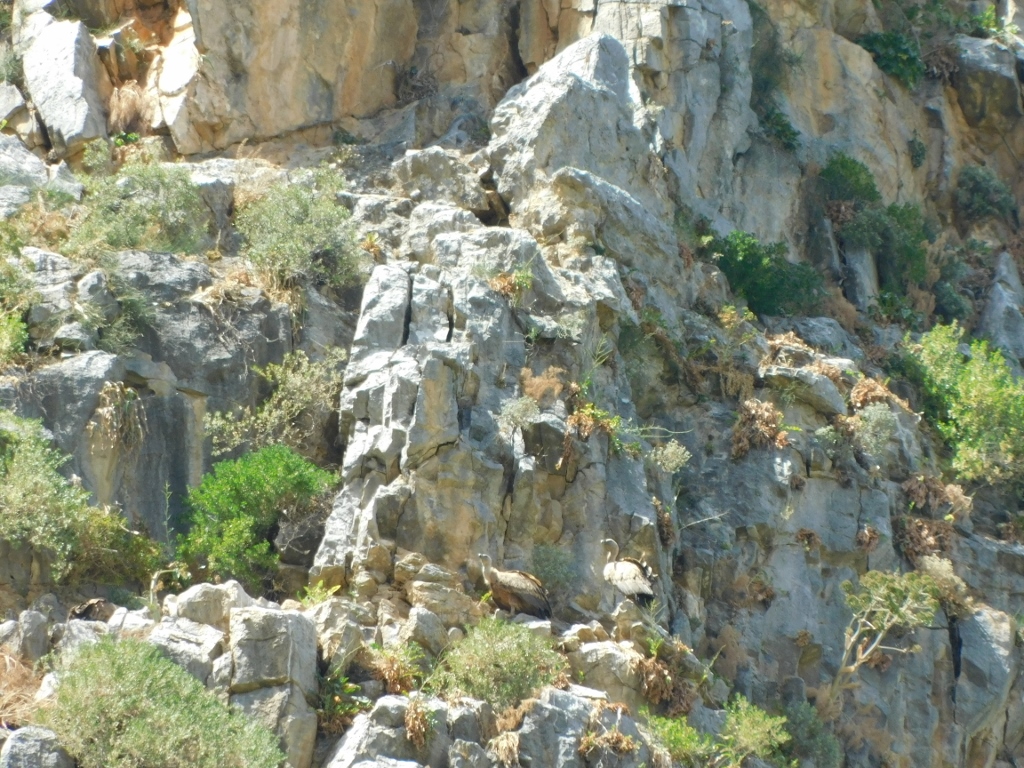 Griffon vultures
Griffon vultures
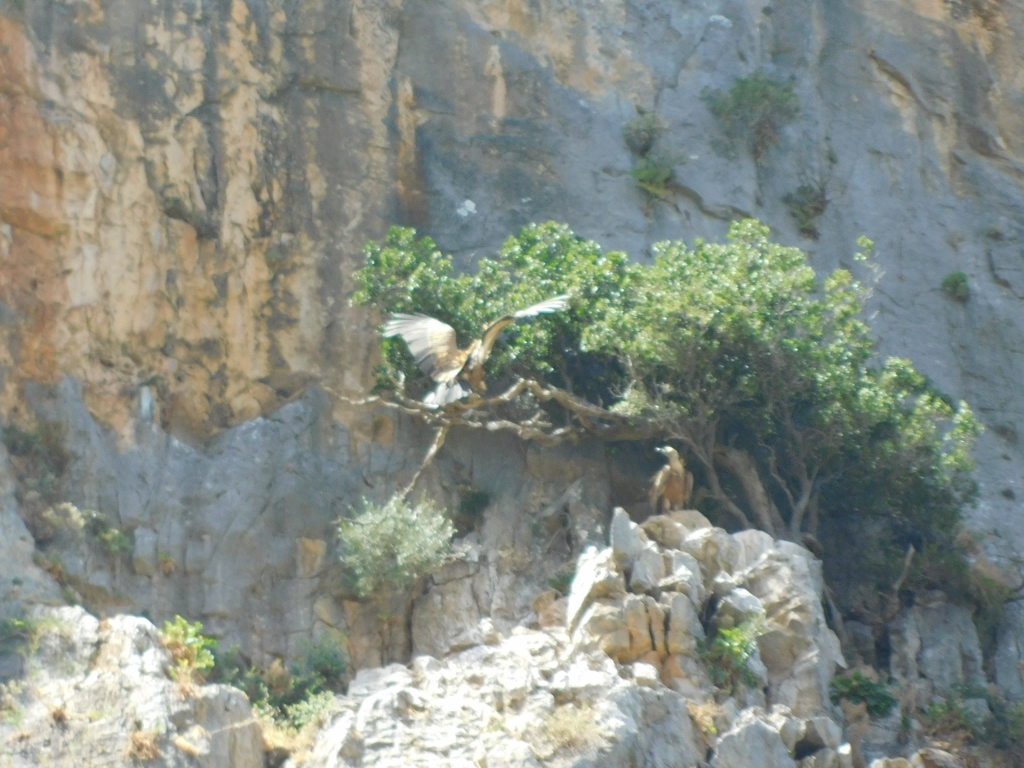 Griffon vultures
Griffon vultures
Is it even necessary for me to emphasise that the experts in the group managed to spot many more birds than I did? Nevertheless, I am modest and what I captured of the griffon vultures is enough for me. After all, the group members who saw other birds are ornithologists, or biologists, or have more experience in birdwatching than I do. I console myself that besides the knowledge and skills, they also had excellent binoculars, making it easier for them to spot various species – both large and tiny. By the way, during the trip, I even got excited about the idea of buying a good pair of binoculars, but when I got home, I realised that I would use them at best once or twice a year. That wouldn’t justify the investment, as good binoculars are quite expensive.
While we were standing at this spot primarily observing griffon vultures, Marko noticed dragon arums (Dracunculus vulgaris), so I also captured them. It is one of the smelliest plants in the world, as it releases the odour of rotting flesh when in full bloom in order to attract insects for pollination. Since there wasn’t strong wind blowing and the plants were growing on the other side of the wire fence present here, we had to move and adjust our position in order to catch even a hint of that stench that is so appealing to insects. For us humans, it is a truly repulsive smell, but insects and plants are content, so everything’s fine.
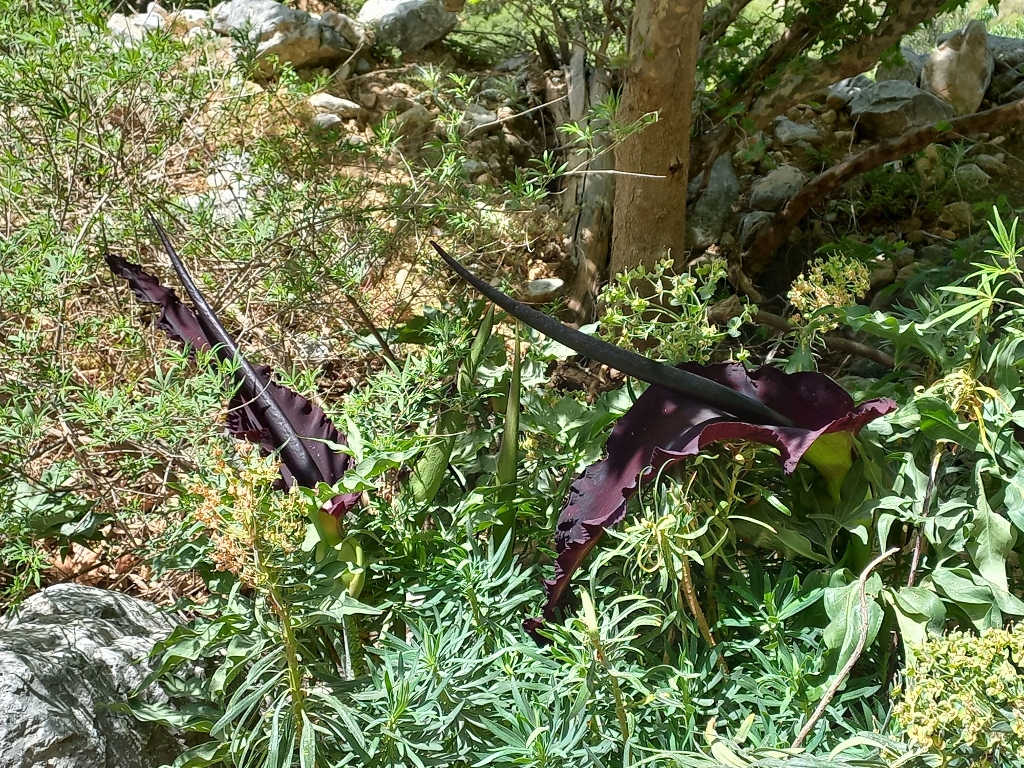 Dragon arums
Dragon arums
There were also other creatures here that could be spotted, such as a charming southern skimmer (Orthetrum brunneum).
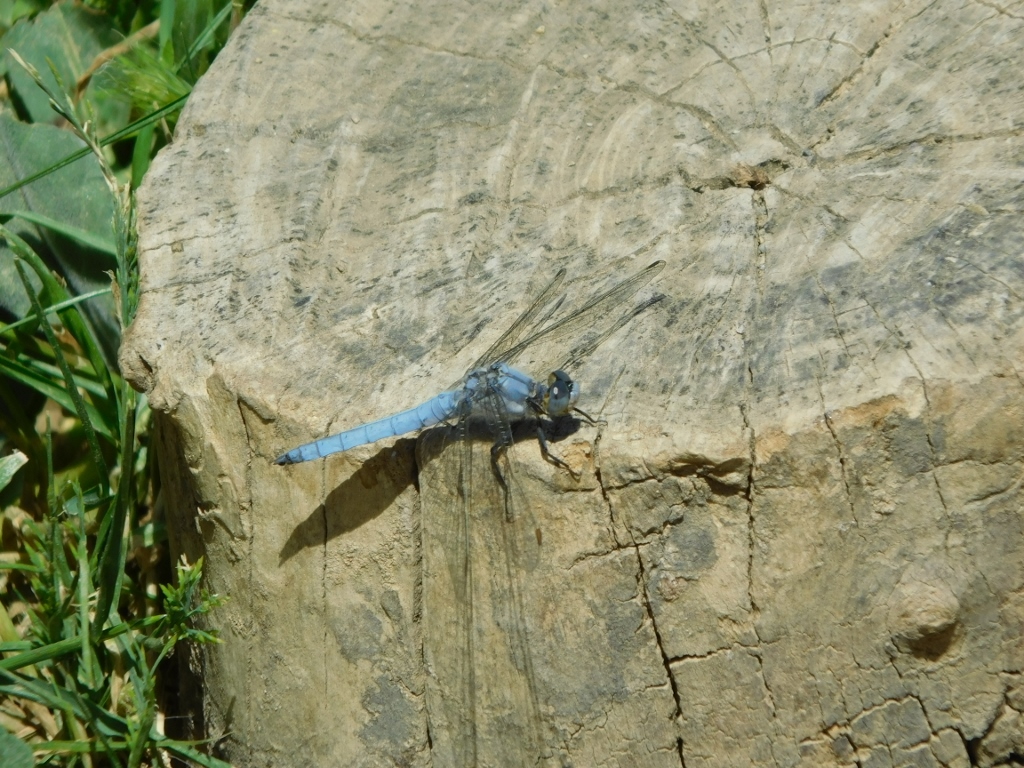 Southern skimmer
Southern skimmer
As I was occupied with observing and photographing the smelly plants and beautiful dragonflies, my friend Sonja diligently continued to watch the cliffs and birds in the sky. While doing that, she was sitting elegantly in the shade of a tree, using a sophisticated pair of binoculars that she had received as a gift from her husband. Elegance is something inherent in humans and it emerges even in remote gorges.
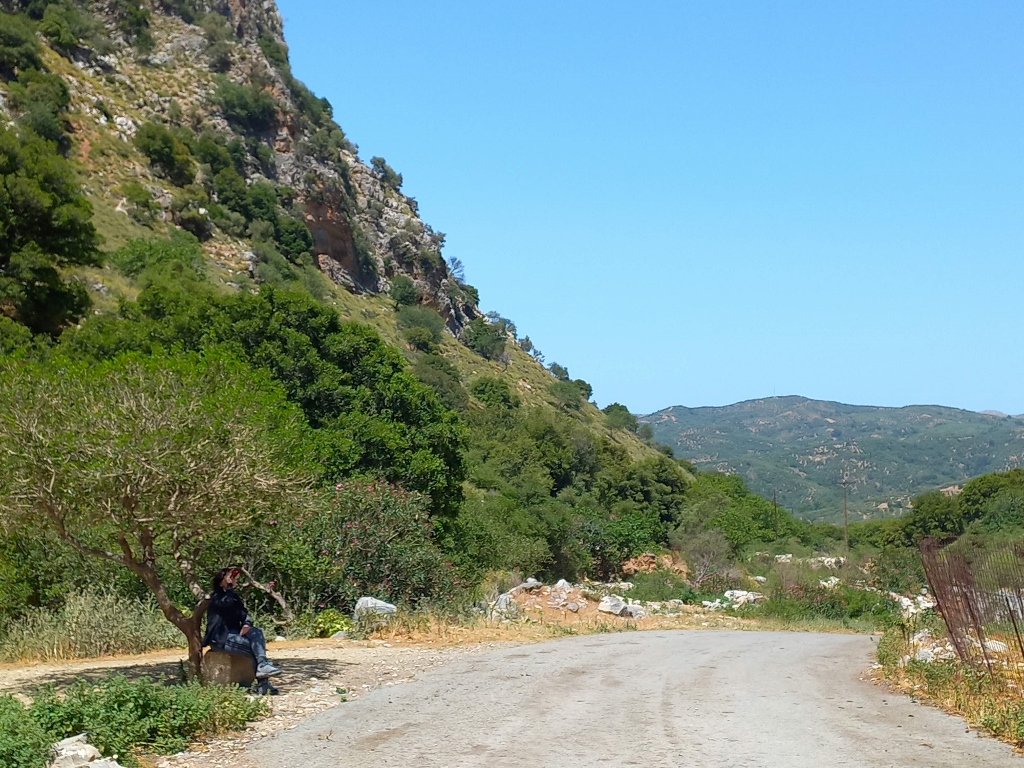 Elegant Sonja
Elegant Sonja
At some point, we all got back into the cars and continued on, which meant driving along a dirt road filled with rocks of various sizes and winding hairpins that took us quite high up. I am not used to driving on such roads and although I was in charge of a sturdy car the chassis of which was high enough, eliminating the risk of damaging it (long ago, I managed to do that to my own car right in the middle of Serbia by puncturing my fuel tank – perhaps that’s why I have the “trauma”), I was particularly careful. My only task was to follow the other cars, but I was still tense. Everything went smoothly, though.
From that height, the view of the surroundings was splendid and the day was just right – sunny, not too hot and without strong winds.
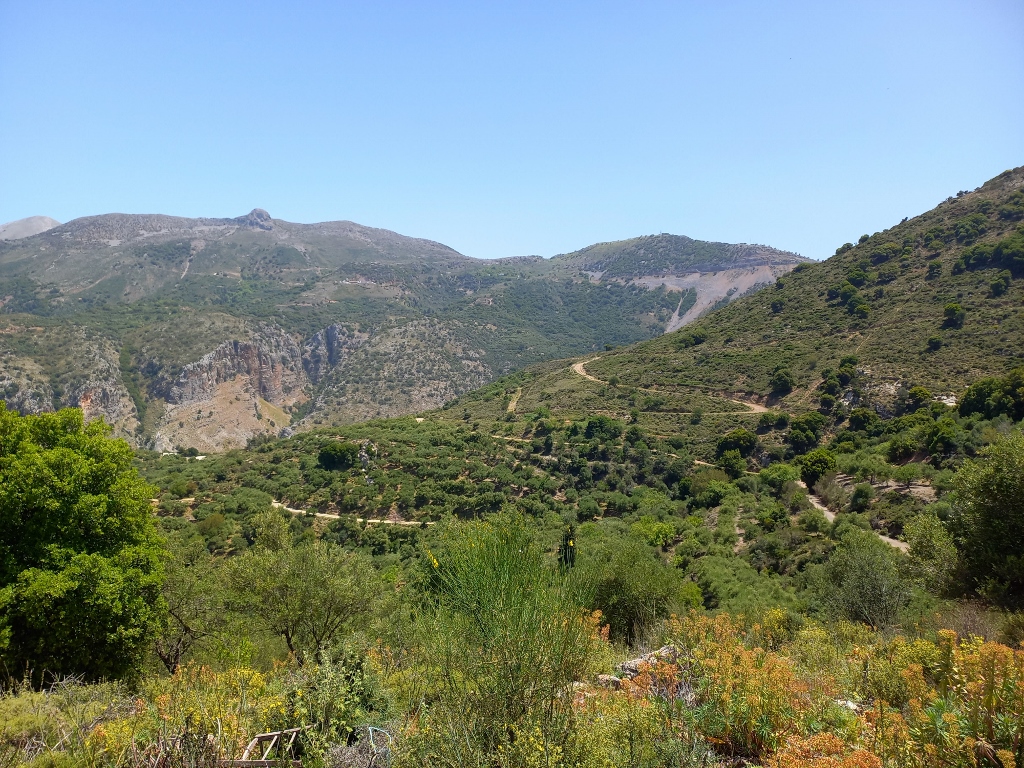 Landscapes around the Roza Gorge
Landscapes around the Roza Gorge
While the other members were still trying to spot birds, I took a short walk, following the dirt road further. There is a house in that area, but it was closed. Nevertheless, evidence of human presence could clearly be seen, not only in the form of the road, the house or fence, but also in the human “decorations” of the surroundings. I am not an expert, but what appears in the next photo to me looks like remains of some wild goat. On a few smaller islands around Crete, you can now find rare specimens of the kri-kri or the Cretan goat (Capra hircus cretica), but as far as I’ve read, they are no longer found on the main island of Crete. Furthermore, judging by the photos I could see online, even the shape of the horns isn’t the same. In any case, this skull and how it was positioned made for a very interesting sight. Or perhaps it was just a symbol of a devil to ward off bad energies?
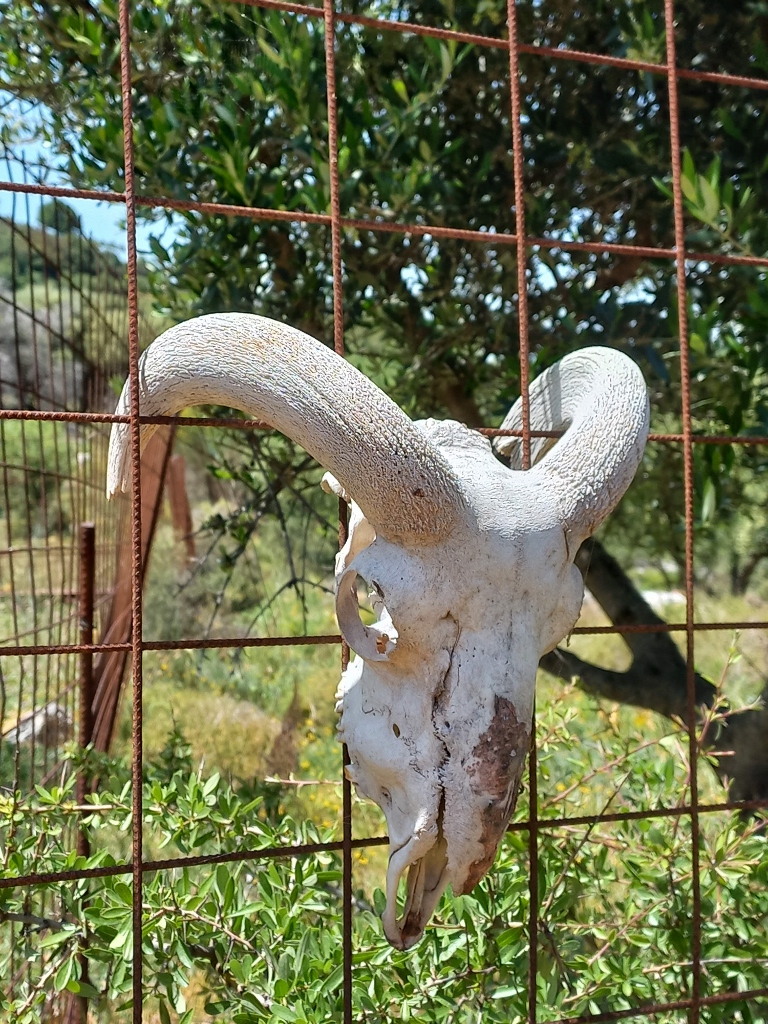 What is this and what is its purpose?
What is this and what is its purpose?
In the vicinity, I also spotted a beautiful Balkan green lizard (Lacerta trilineata). It stood still in a good spot long enough for me to capture it nicely on camera.
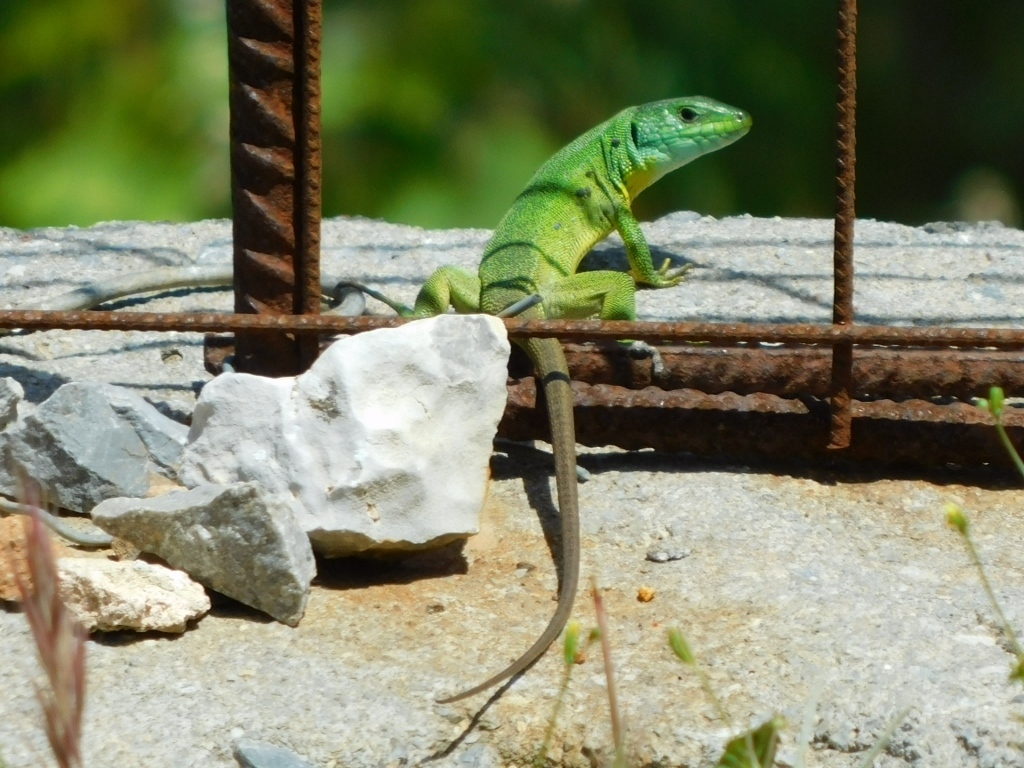 Balkan green lizard
Balkan green lizard
Then I returned to the spot where the group was observing a couple of vultures, but they were too high for me to capture with my camera, so I walked down about a hundred meters to a small elevation with some kind of transmitter at one end. From there, I had a wonderful view of the valley near the Roza Gorge.
 Area close to the Roza Gorge
Area close to the Roza Gorge
While I was taking photos of this valley, I noticed that a whole flock of griffon vultures was slowly gliding on the thermals from that side towards the gorge. I was thrilled and managed to capture them in a video format:
I wanted to call the other group members, but I realised that the vultures would fly away by the time they reached the spot where I was standing at that moment. Besides, they had already seen the birds when the vultures soared upwards.
Near the lookout point where I stood, I also came across numerous specimens of a plant I had seen elsewhere. It was a (very) prickly, spiny or thorny burnet with lovely berries (Sarcopoterium spinosum).
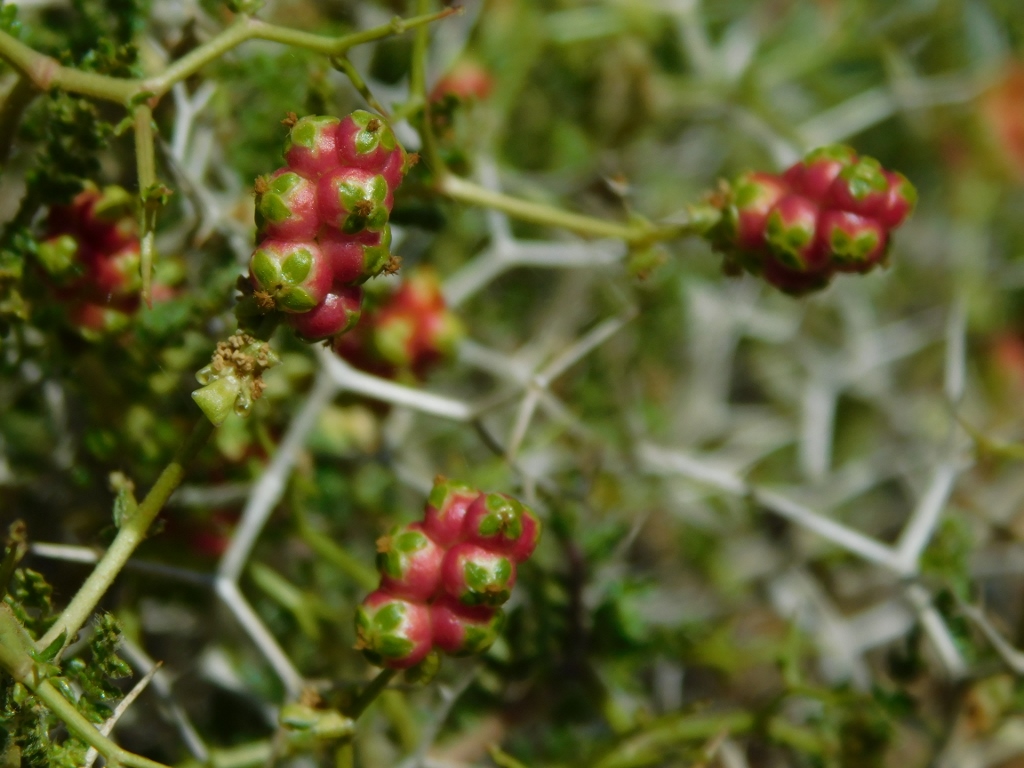 Prickly, spiny or thorny burnet
Prickly, spiny or thorny burnet
Soon we were on the move again and from where I had parked the car, I could get a good view of the Aposelemis Reservoir behind the Aposelemis Dam. This is an embankment dam and the largest water management project on Crete. The purpose of the reservoir is to provide drinking water for the cities of Heraklion and Agios Nikolaos, as well as several smaller settlements. In fact, we had already passed by the reservoir on the way from Malia and, at that time, I thought the dam was probably new and the reservoir was just filling up. The dam is indeed new enough; its construction was completed in 2012. However, from what I’ve heard, the reason for the low water level is that there was very little rainfall during the winter of 2023/24, causing the reservoir to drain. I could personally notice that there had been less rainfall on Crete this time than two years earlier at a few other places in the following days.
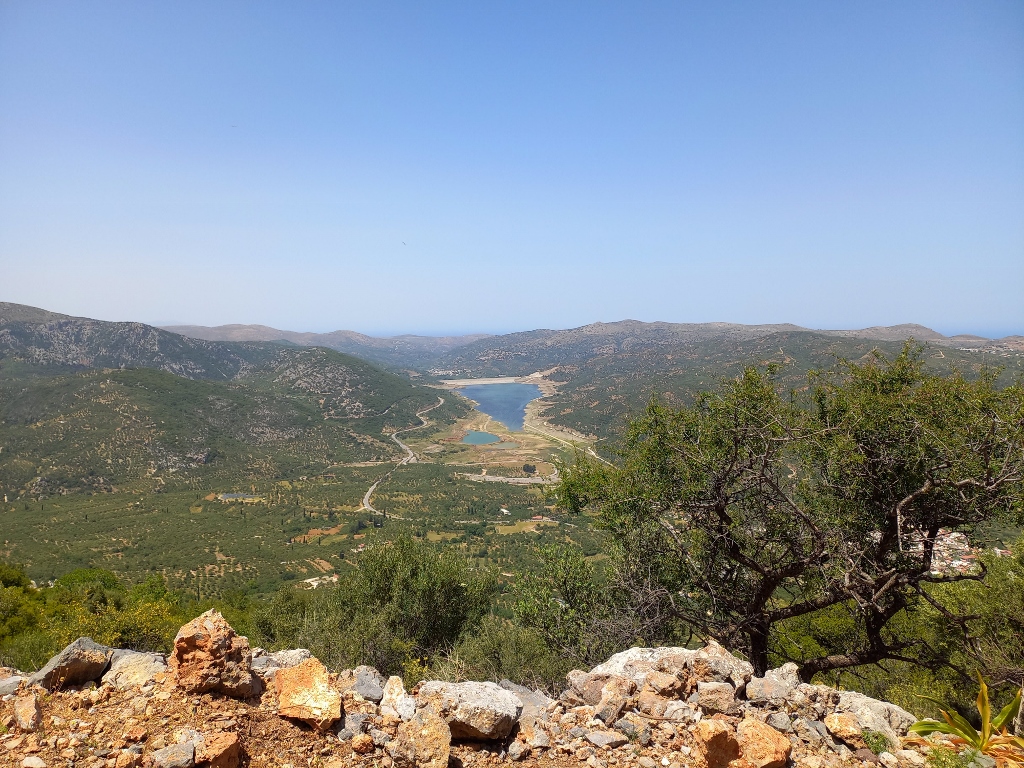 Aposelemis Reservoir
Aposelemis Reservoir
The next place we stopped at was the church of Agia Marina (dedicated to Saint Marina the Great Martyr) and from there, we could once again enjoy the view of the beautiful surroundings and the numerous olive trees that grow throughout Crete. Moreover, it is believed that one of the oldest, if not the oldest olive tree in the world, grows on Crete. However, it is located on the western side of the island near the city of Chania and, unfortunately, we didn’t have time to go there on this occasion. After all, Crete is the fifth largest island in the Mediterranean.
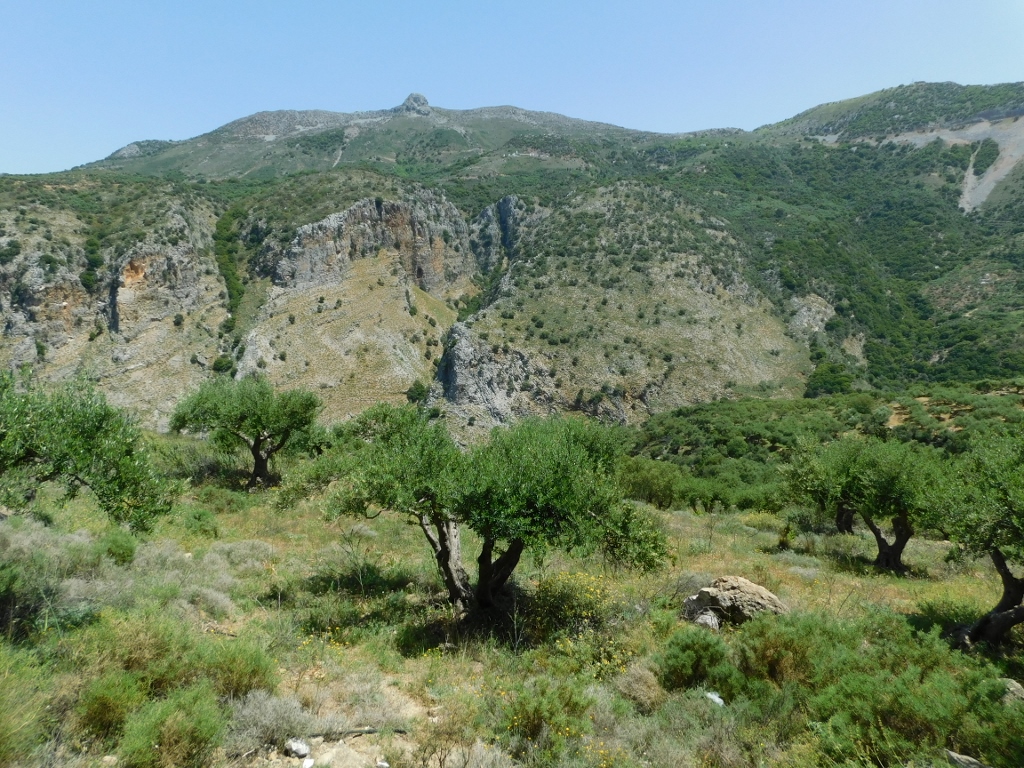 Area close to the Roza Gorge
Area close to the Roza Gorge
As for the church, it was closed, but there was a convenient spot next to it where we could park our three cars, so we made a short stop there to walk around and observe the sky and the surroundings. Quite close by, on the outer side of the churchyard, we saw the remains of some structure. This seemed very unusual to me and since it offered a view over the valley below the mountain, I thought it might have served as some kind of an observation post from the 19th century and that was that. I would soon realise that this was actually the remains of a windmill.
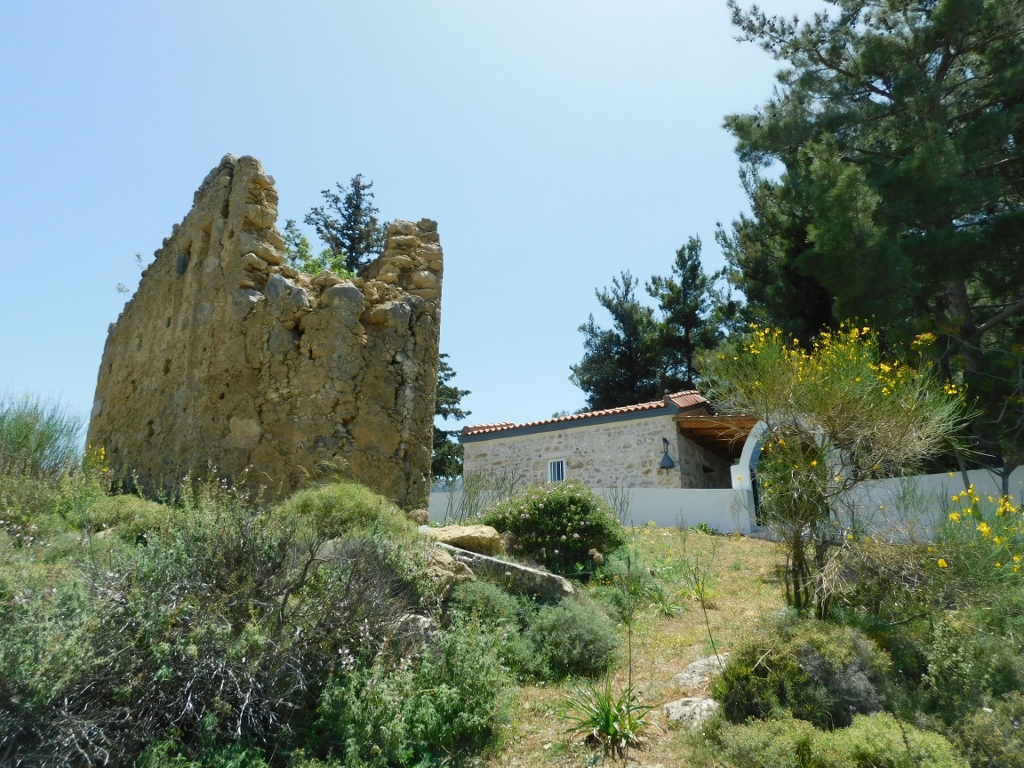 Church dedicated to St. Marina (right) and the remains of a windmill (left)
Church dedicated to St. Marina (right) and the remains of a windmill (left)
While we were walking around the churchyard, Sonja noticed something unusual on a tree and it was clear that something had once lived there.
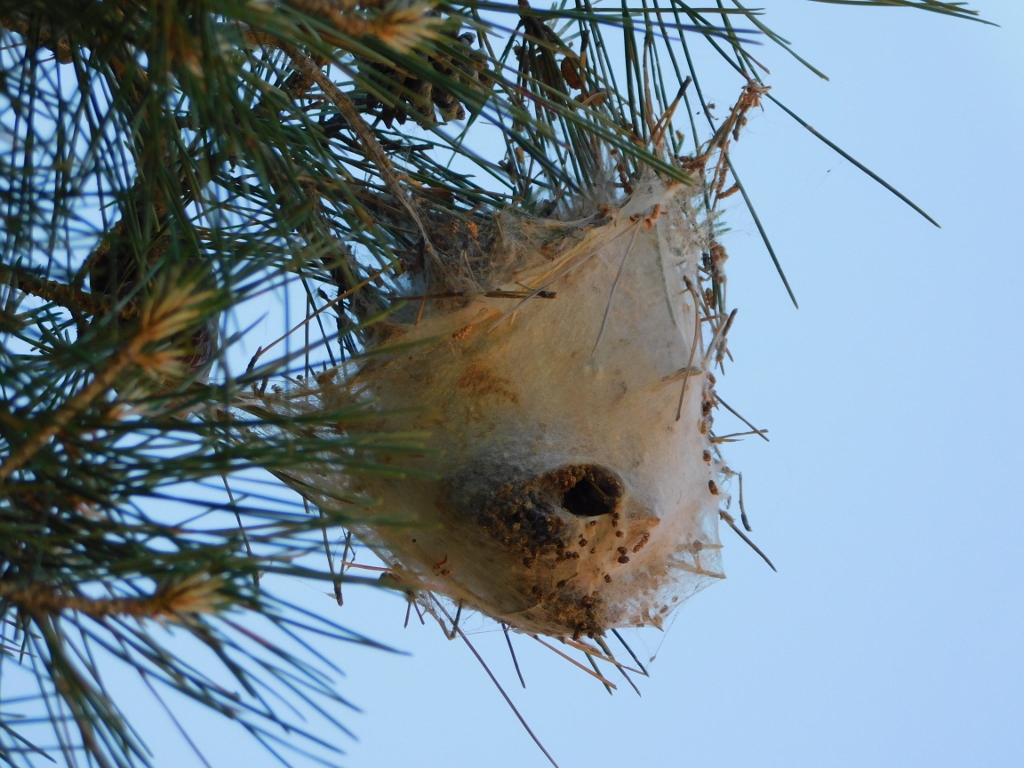 Parasite worm’s nest
Parasite worm’s nest
Fortunately, we were accompanied by biologists on this trip (I’m thinking of Saša here), so we quickly learned what it was all about. There is a parasitic worm that was brought from America to Europe and it particularly attacks the Aleppo pine (Pinus halepensis) causing a condition known as witch’s broom. The conclusion was that this was its nest.
Also, Vuk found an old, fallen nest of this parasitic worm on the ground, so we also looked at what it looked like inside.
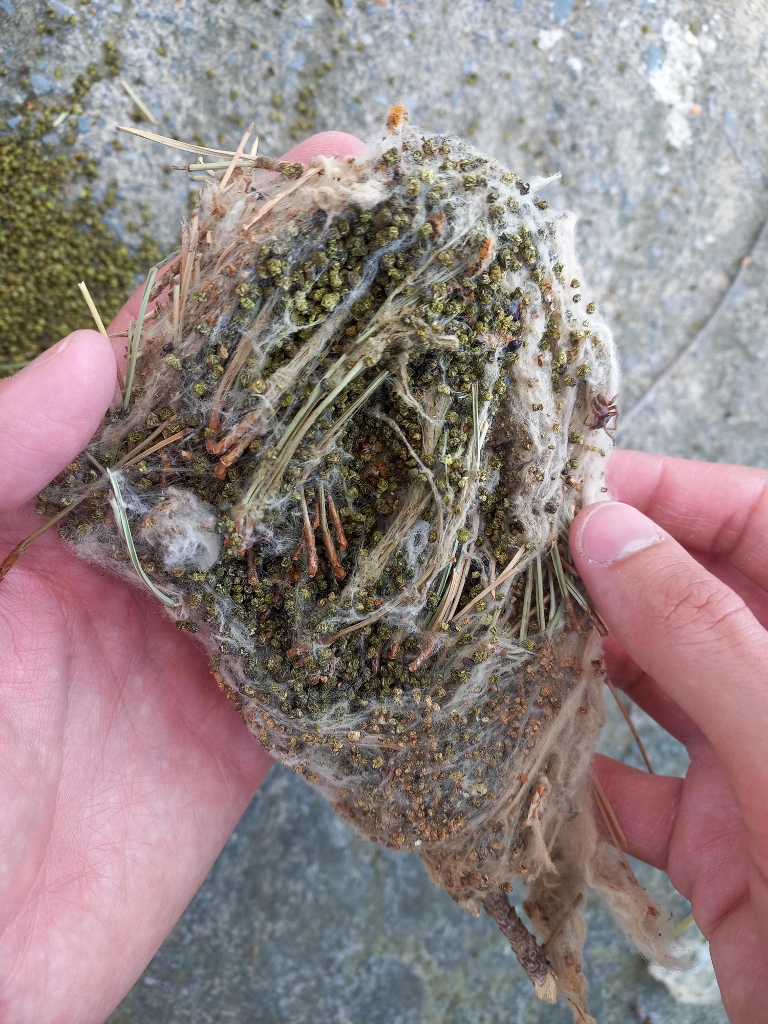 Interior of an old next of a parasite worm
Interior of an old next of a parasite worm
And then, from one spot, I noticed in the distance a pass where I discerned some interesting structures.
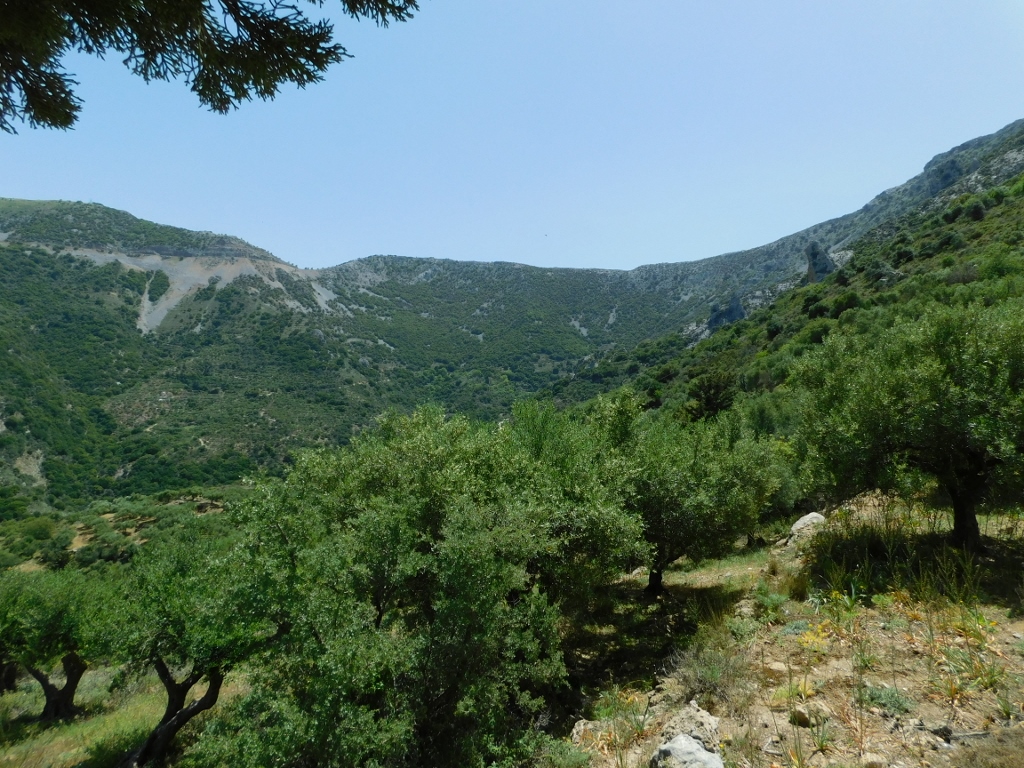 The pass I’m referring to is up and left, continuing from the gray part of the mountain
The pass I’m referring to is up and left, continuing from the gray part of the mountain
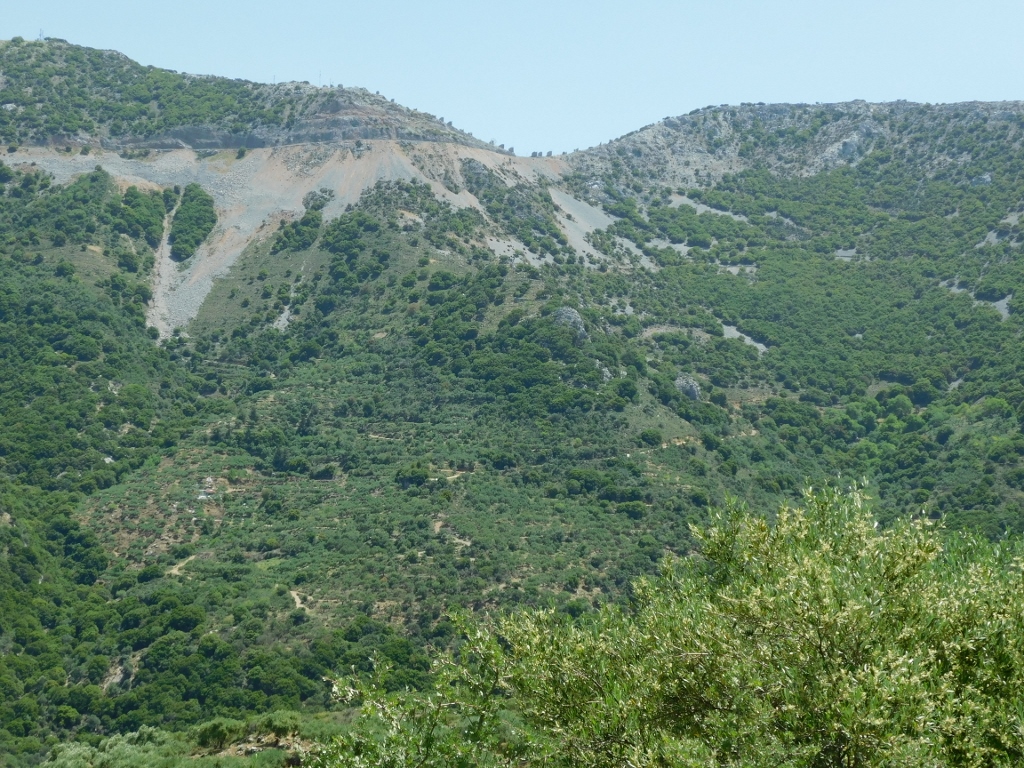 This is what it looks like when you zoom in a little
This is what it looks like when you zoom in a little
Saša told us here that there were windmills on that pass and that we would go there. I was really excited.
We moved on by our cars and first descended to the lower parts, but soon we were driving uphill again and at one point, we stopped at a parking area on the side. I didn’t see any birds there, but there was a beautiful view of the Kardiotissa Monastery in the village of Kera, dedicated to the Theotokos (Mother of God).
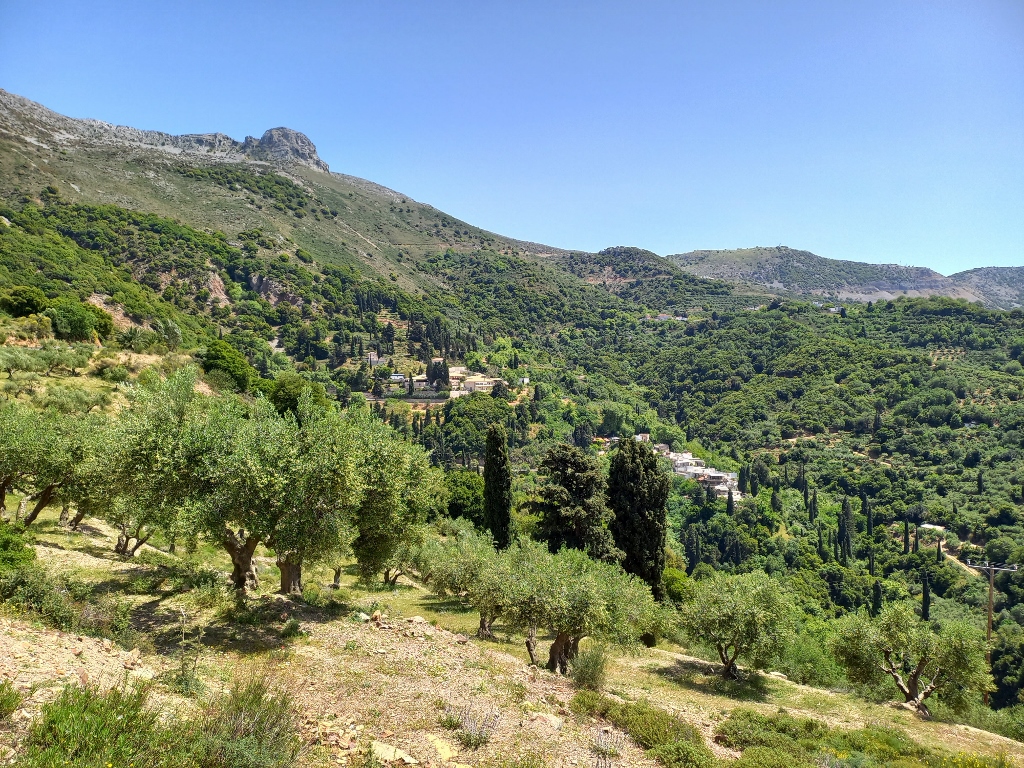 View at the Kardiotissa Monastery
View at the Kardiotissa Monastery
We even stopped again at another parking area a bit further to regroup because our convoy had become somewhat scattered in the meantime, but it was ideal as the view towards the valley and the Aposelemis Reservoir was exceptional. In the photos, you can also see the winding road we had previously driven on (on the elevation between the spot from where I’m taking the photos and the reservoir). They are in the middle of the first photo and more to the left in the second one.
 North view towards the Aposelemis Reservoir
North view towards the Aposelemis Reservoir
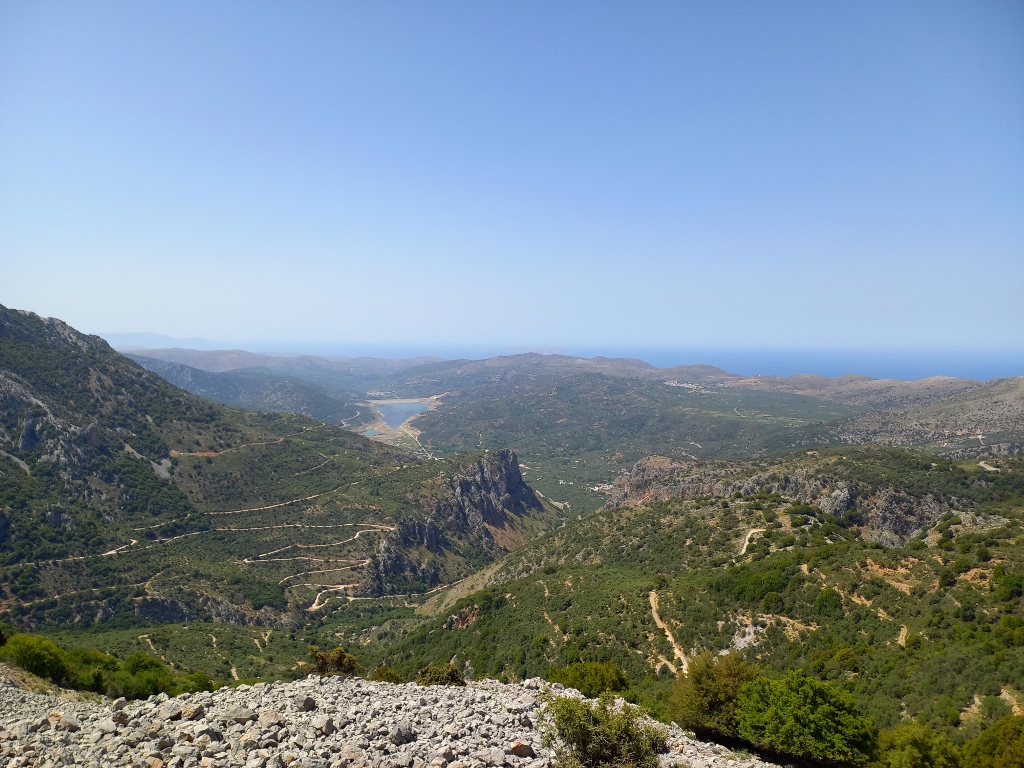 North view towards the Aposelemis Reservoir
North view towards the Aposelemis Reservoir
After a short break, we continued towards the Ambelos Pass, where the windmills were located, and I could already imagine myself walking around and filming them. Then I realised utterly confused that Saša in the lead car wasn’t stopping and neither was Marko in the second car. There was no other choice, so I continued descending the mountain behind them, casting longing glances at the remnants of the windmills we passed by.
Fortunately, we stopped very soon because it was time for lunch. We sat down at a restaurant in the village of Pinakiano, which seemed to have just opened that day, but the most important thing was that they had lovely seating areas on the lawn, shaded from the sun.
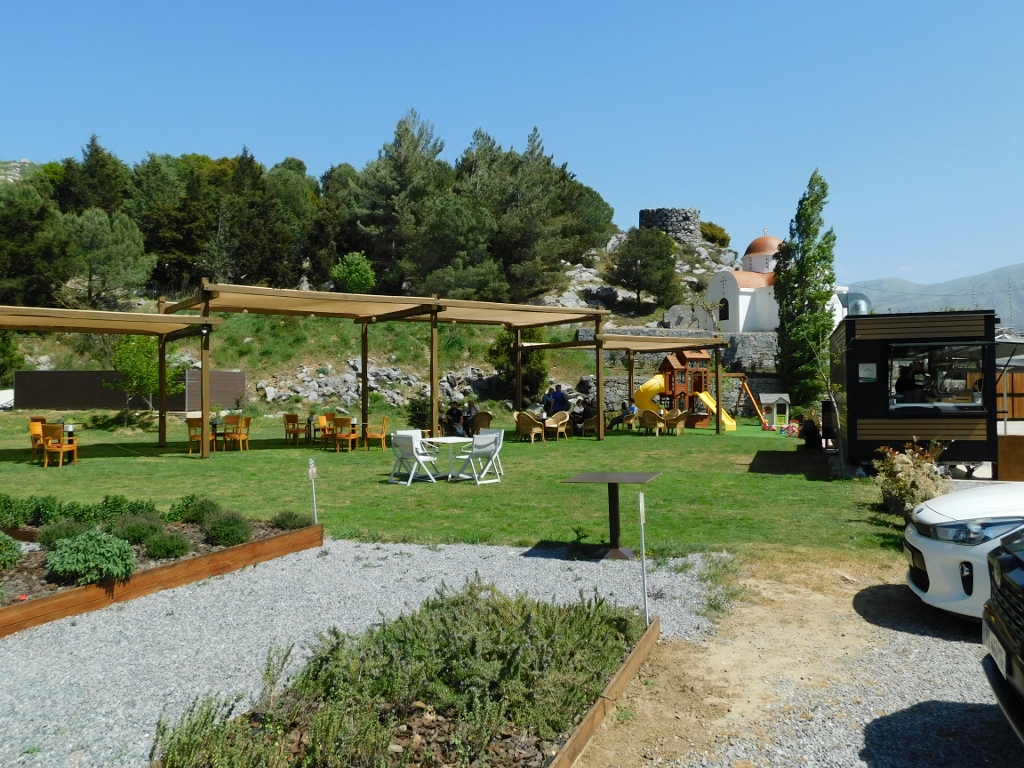 Restaurant in Pinakiano
Restaurant in Pinakiano
While waiting for lunch, I took the opportunity to explore and take photos of the beautiful garden with herbs that is cultivated in tall beds just a few metres away from the dining area (a part of the garden can be seen in the lower left of the previous photo). I guess the garden is maintained by the restaurant. There were about a dozen different plants here, but I’ll mention only two. One is endemic, meaning it only grows in Crete, and it is called the dittany of Crete (Origanum dictamnus). The other is found throughout the Mediterranean region, including Serbia where it is called smilje and is often mentioned in folk songs and even in some women’s names (for example, I have a dear colleague named Smiljana). Its English name is dwarf everlast (Helichrysum arenarium) and when I took a photo of it here it still had not bloomed.
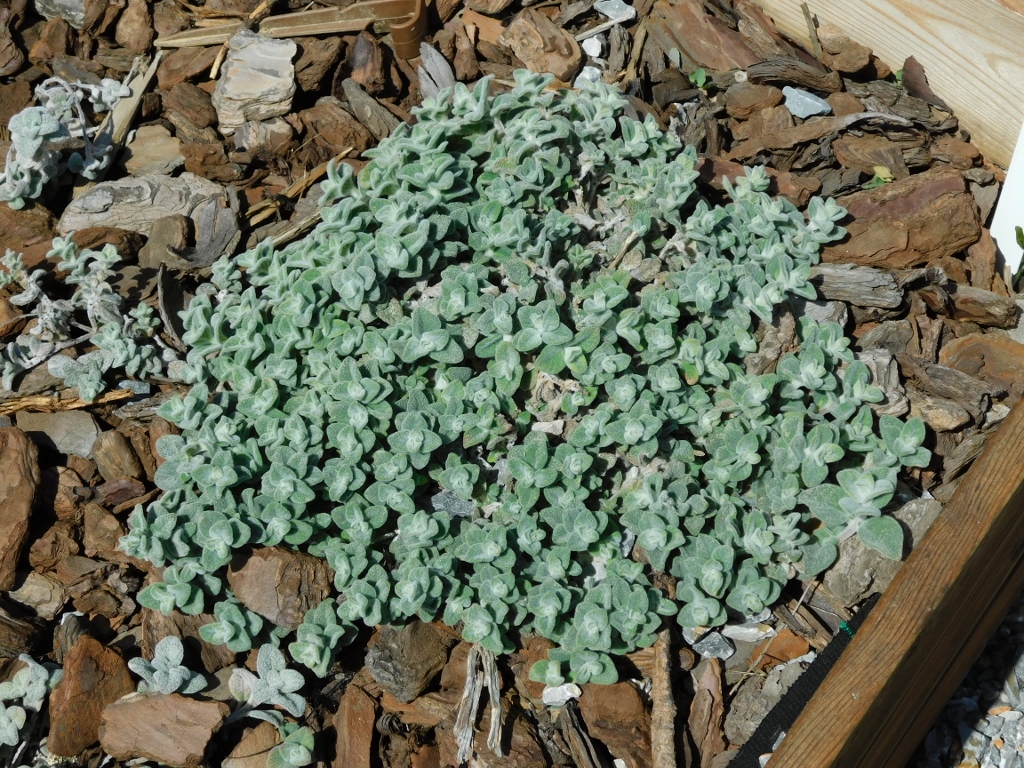 Dittany of Crete
Dittany of Crete
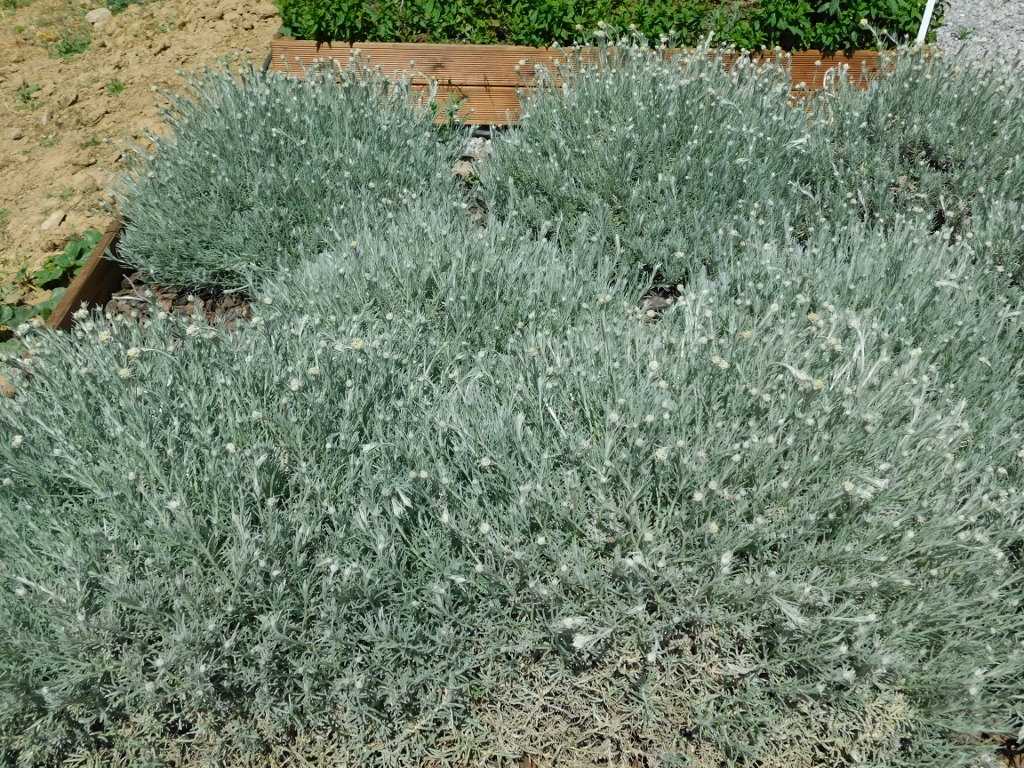 Dwarf everlast
Dwarf everlast
Since the lunch break dragged on a bit, in agreement with the rest of the group, the three of us – Sonja, Beba, and I – decided to return to the windmills at the pass to get a better look at them. To start with, I should mention that the windmills are called the Lasithi Plateau Windmills.
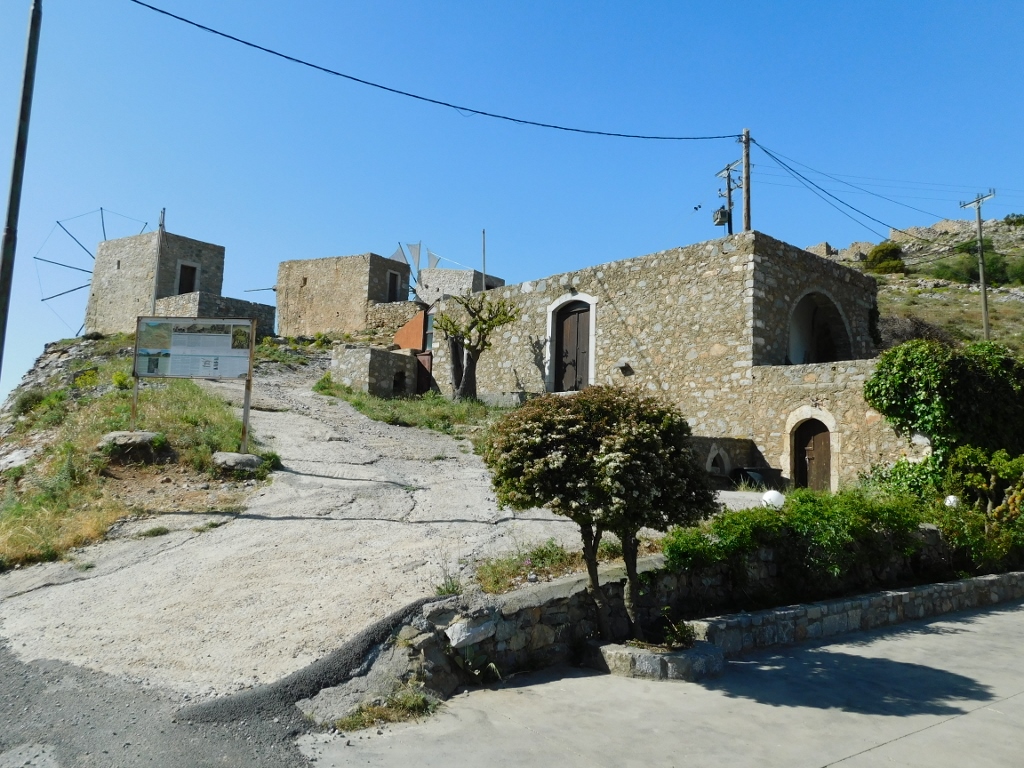 Lasithi Plateau Windmills
Lasithi Plateau Windmills
There are signs here where you can read some very interesting information. For example, about the history of windmills. I learned that the first windmills were built in Mesopotamia and China around 700 BCE and this invention was brought to Europe by the Crusaders. Windmills were mainly used for grinding agricultural products and pumping water (e.g., in the Netherlands).
Windmills began to be built in Crete during the Byzantine period, but they were mostly fixed, meaning they were suitable only for wind blowing from one side, as their rotation axis did not move depending on the wind direction. These windmills were used for grinding grains and their ground plan was uniform – roughly in the shape of a horseshoe, with the grinding mechanism located in the curved part where the sails were. The entrance was on the opposite side.
Today, the remains of numerous windmills can be seen at the elevations on the left and right sides of the road that leads over the Ambelos Pass.
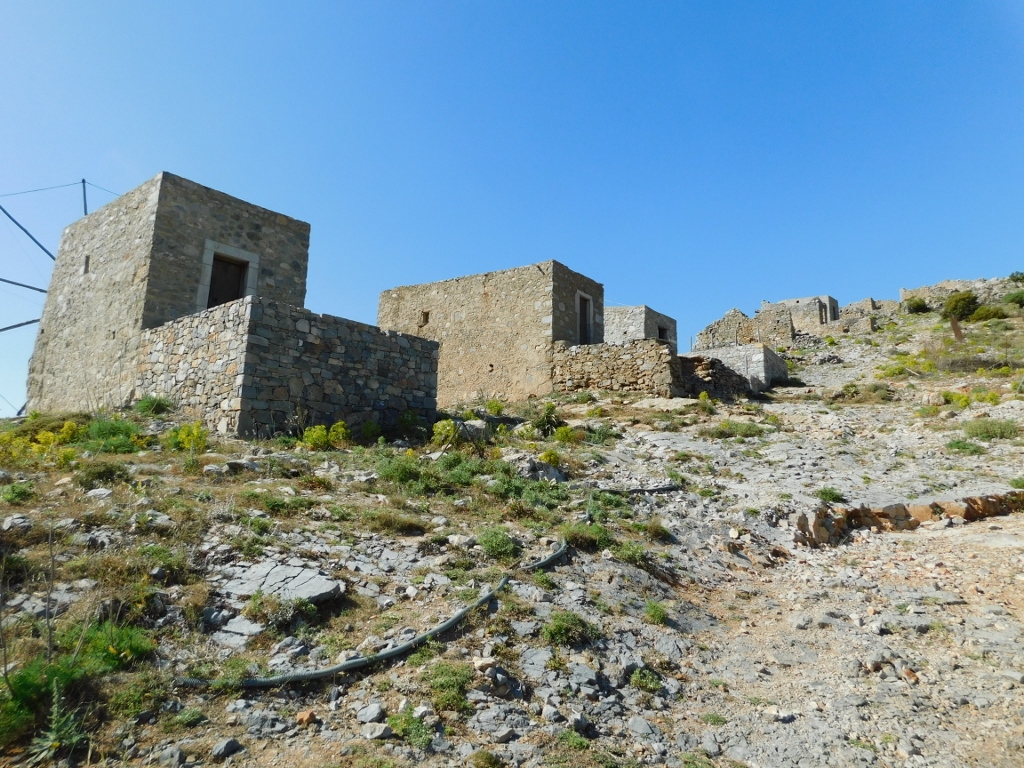 Lasithi Plateau Windmills
Lasithi Plateau Windmills
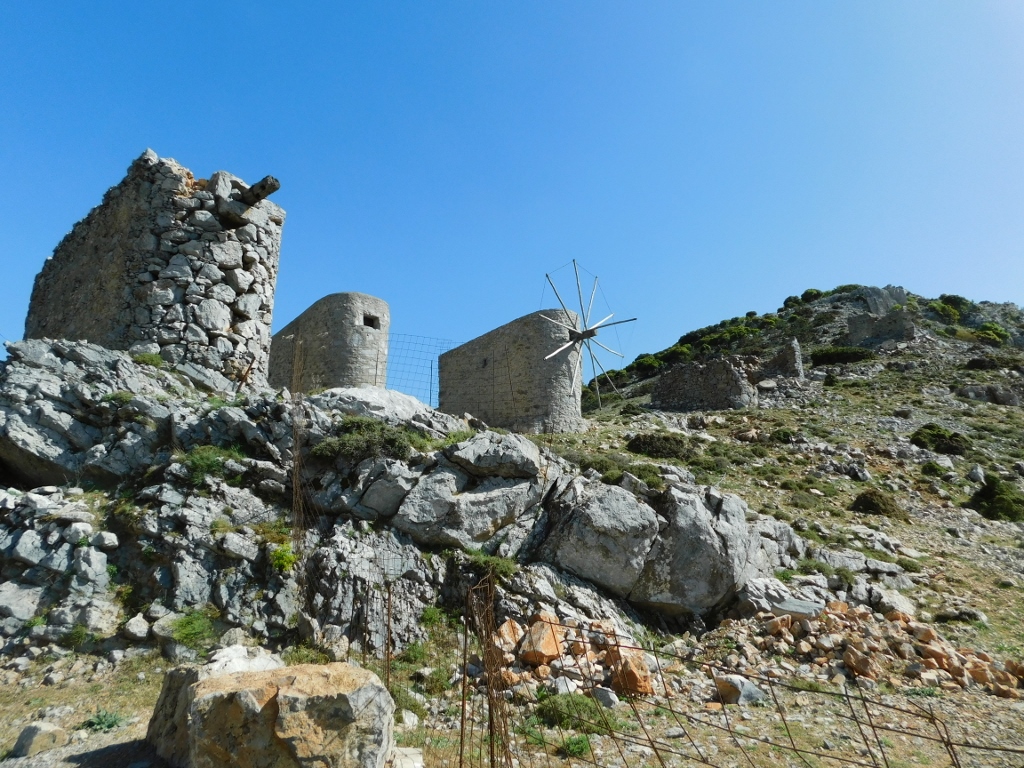 Lasithi Plateau Windmills
Lasithi Plateau Windmills
Bearing in mind the rich agricultural area of the Lasithi Plateau, the winds that seem to blow more frequently and stronger on Crete than on the other islands in the Mediterranean, as well as the rocky heights at the Ambelos Pass, that provided a source of construction material, this was an ideal location for building the windmills. Originally, there were 27 of them, but today, the remains of 24 windmills have survived. They are in various stages of decay, but some have been reconstructed, allowing us to see what they looked like in their prime.
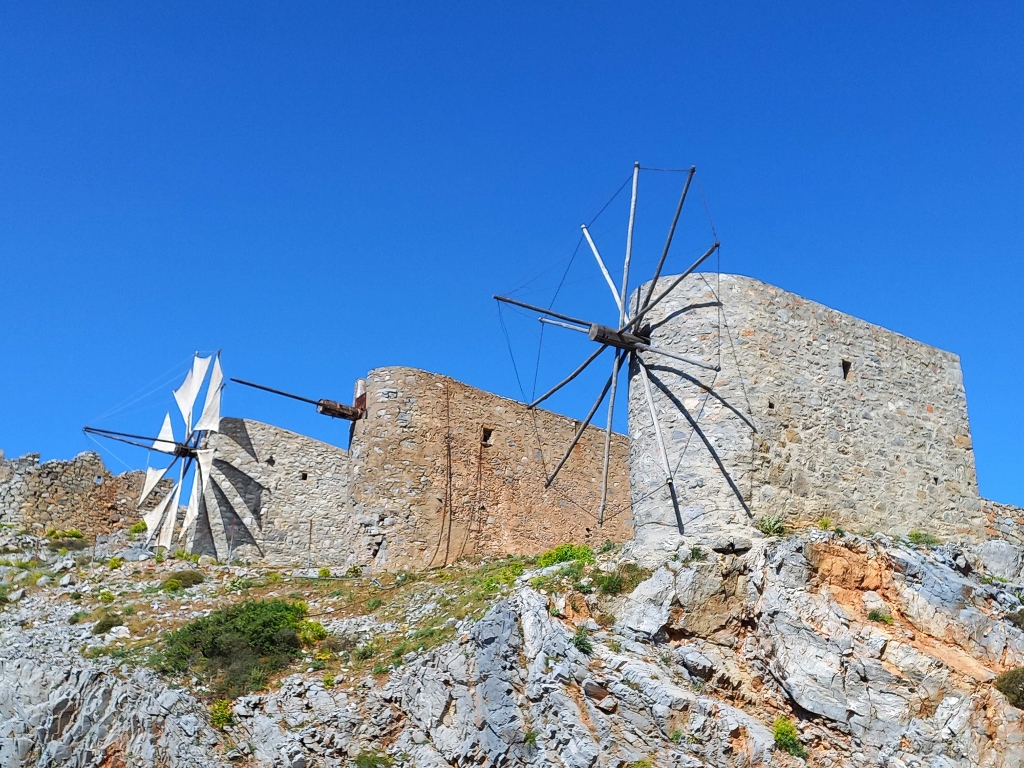 Lasithi Plateau Windmills
Lasithi Plateau Windmills
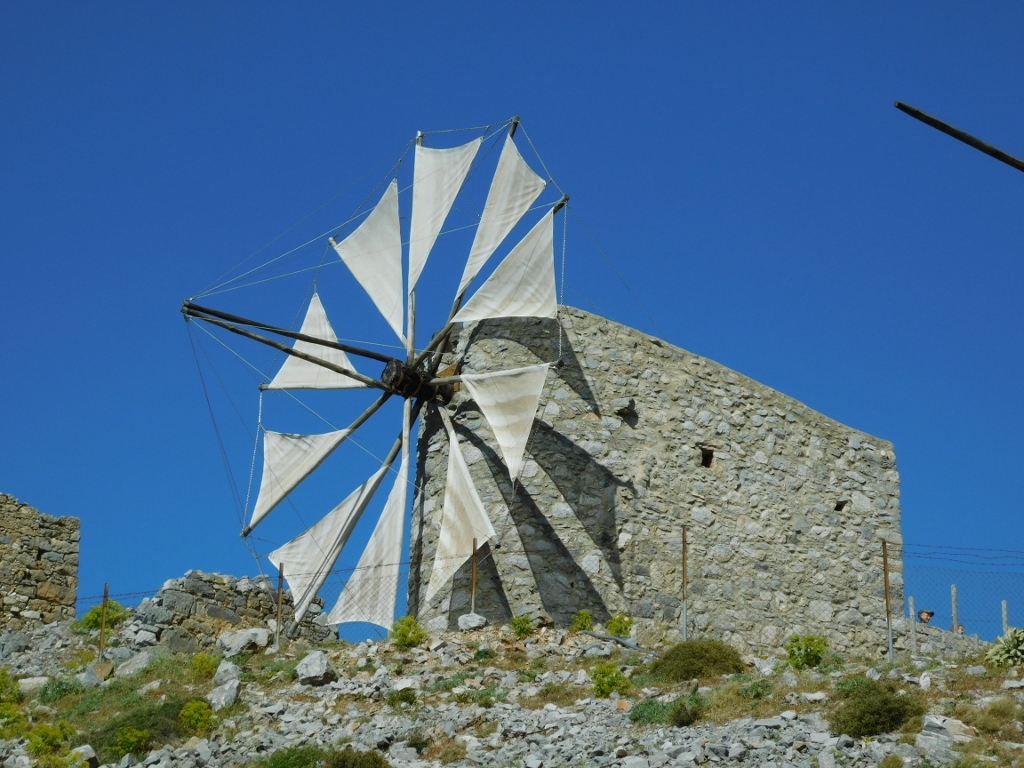 Lasithi Plateau Windmills
Lasithi Plateau Windmills
I walked to the other side of the pass from where I had parked the car to get a better view of the windmills, but from there, I could also see the beautiful landscape where we had been earlier.
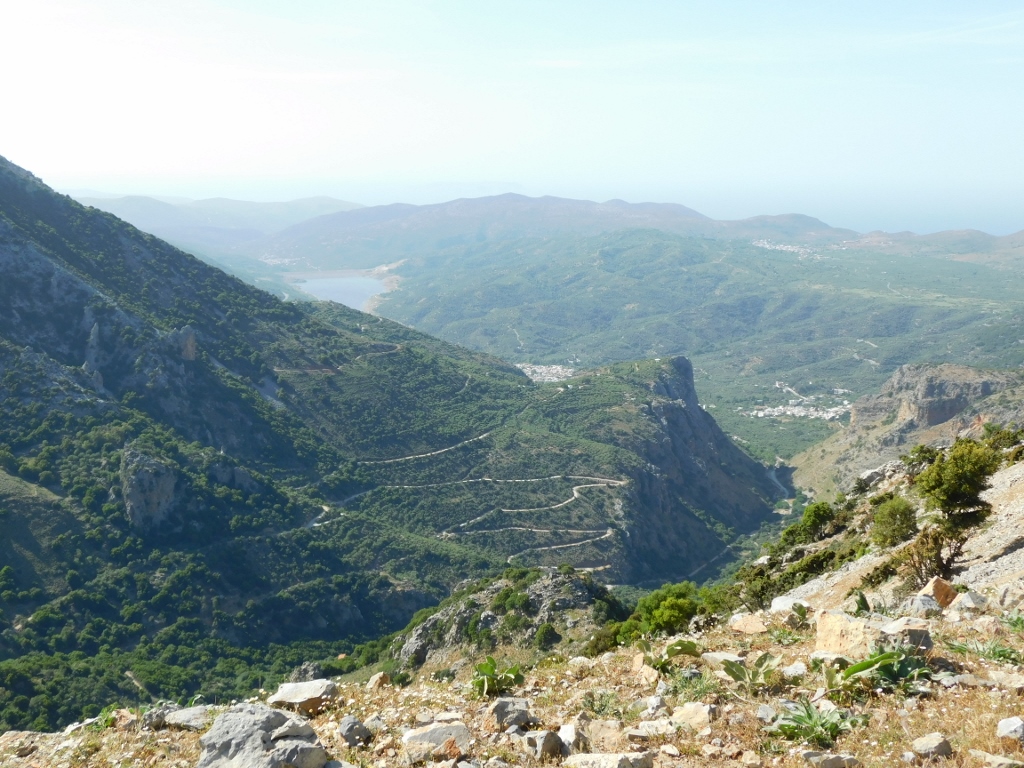 North view towards the Aposelemis Reservoir
North view towards the Aposelemis Reservoir
Soon after, we returned to the group and then continued driving around the Lasithi Plateau. While we were still in the area near the village of Pinakiano, we could see more windmills, of a slightly different construction, at the foot of the high mountains.
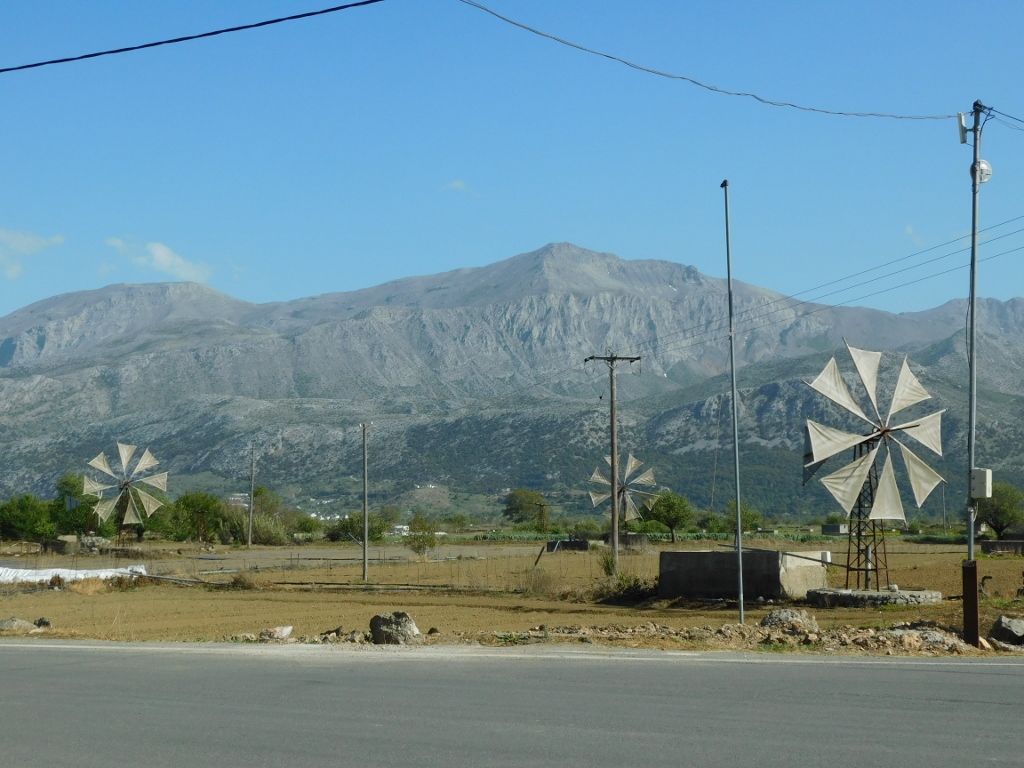 Windmills on the Lasithi Plateau
Windmills on the Lasithi Plateau
As far as I understood, we chose this route because Saša, who had been here with his wife Ljilja several times, wanted us to see how beautiful the Lasithi Plateau is. And it is indeed so. But...
Since I was driving the third car and the road was very winding and constantly going up and down, I couldn’t really look out the window much and I certainly didn’t take any photos while driving. Also, since I wasn’t alone, I felt it wouldn’t be fair to make stops where I specifically liked. However, the little I could glimpse left and right in the easy parts of the road was indeed exceptionally beautiful.
After some time, we reached the vicinity of the northern coast and as we got onto the new National Road, it took us past the famous Selinari Monastery or, to be more accurate, the Monastery of St. George Selinari (this refers to the Selinari Gorge), but we didn’t stop there.
The day was actually quite long and filled with activities, so it felt good to return to Malia and the hotel. There was already a clear idea of where we wanted to go the following day. And I was really looking forward to it and couldn’t wait for the new day.